Prepare to be delightfully surprised by the sheer simplicity and incredible taste of this Cream Cheese Pound Cake Recipe. With just a handful of staple ingredients, you can effortlessly create a dessert that is rich, moist, and utterly irresistible. The magic lies in the addition of cream cheese, transforming a classic pound cake into a velvety, tender masterpiece that melts in your mouth with every bite.
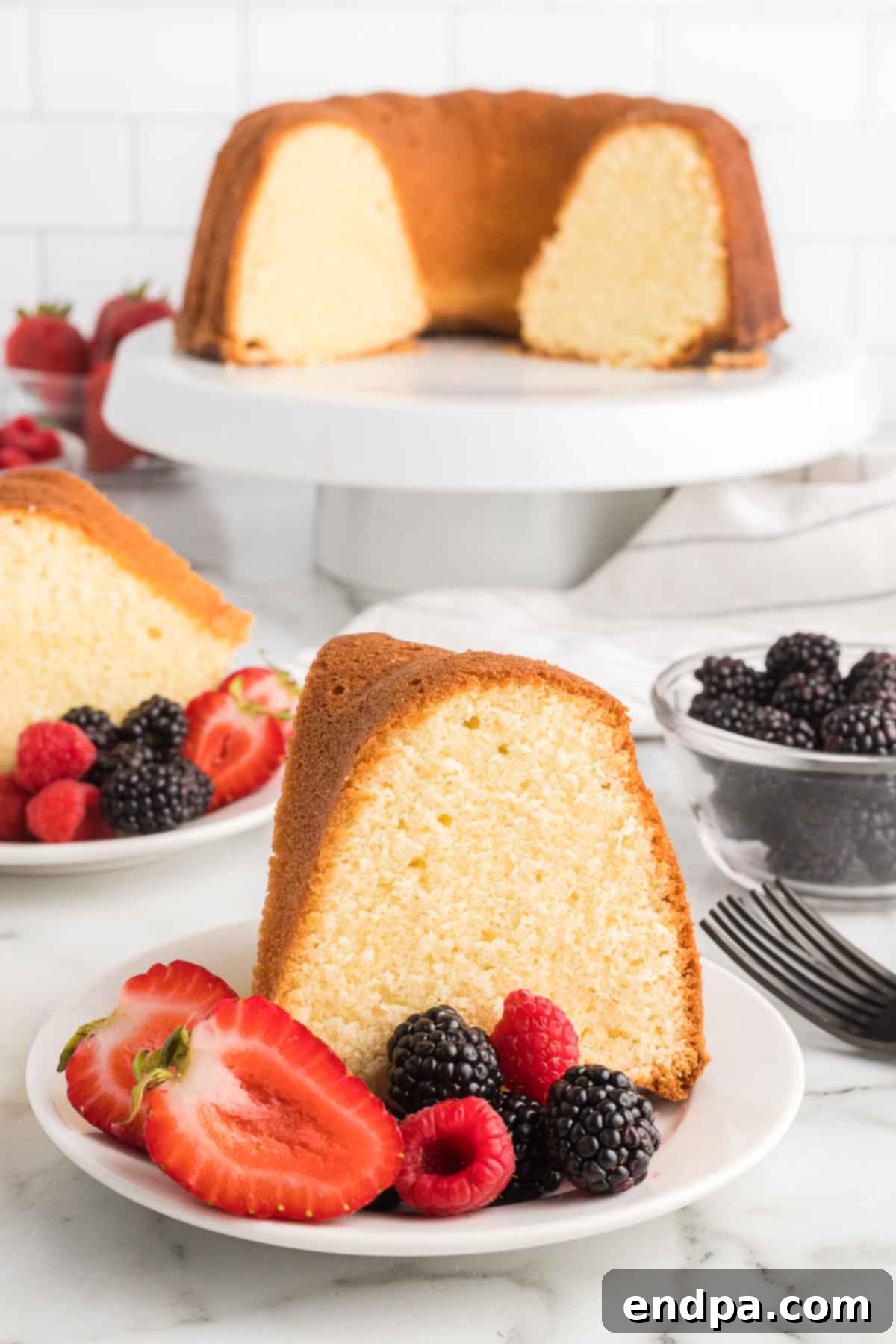
The thought of baking a homemade pound cake might seem daunting to some, but this cream cheese variation is designed for success, even for novice bakers. Utilizing common pantry ingredients that you likely already have on hand, this recipe is straightforward and incredibly rewarding. The result is a perfect pound cake with an exceptionally soft texture and a flavor profile that everyone will adore. Forget dry, crumbly cakes; this recipe delivers a consistently moist and flavorful experience that will become a go-to in your baking repertoire.
Having recently perfected a classic pound cake recipe, I was inspired to explore a cream cheese variation, curious about the unique richness and texture it could bring. The outcome was beyond expectations! This easy oven-baked recipe quickly became a family favorite, praised for its incredible moistness and delightful tang from the cream cheese. It’s a versatile dessert, perfect for any occasion, from casual family gatherings to elegant dinner parties. Another beloved recipe in our collection is the bright and zesty Orange Pound Cake, but this cream cheese version offers a uniquely decadent twist.
Table of contents
- Why We Love This Recipe
- The Science of Pound Cake: What Makes it Special?
- Ingredients for the Perfect Cream Cheese Pound Cake
- How to Make Cream Cheese Pound Cake
- Elevate Your Cake with Delicious Toppings
- Storage and Freezing Tips
- Expert Baking Tips for Pound Cake Perfection
- Frequently Asked Questions
- More Easy Pound Cake Recipes
Why We Love This Recipe
Traditional pound cake is often characterized by its dense and buttery texture. However, the ingenious addition of cream cheese to this recipe introduces a remarkable transformation. It doesn’t just add flavor; it fundamentally alters the cake’s structure, making the batter bake into an incredibly light and fluffy cake that still retains its rich, decadent qualities. The cream cheese ensures a significantly more moist crumb than a classic pound cake, preventing dryness and enhancing its overall appeal. Each forkful delivers a delightful balance of traditional pound cake flavors with a subtle, tangy cream cheese twist that elevates it to a whole new level of deliciousness. This is not just a cake; it’s an experience – a perfectly balanced dessert that’s both comforting and sophisticated.
The Science of Pound Cake: What Makes it Special?
Understanding the basic principles behind pound cake helps appreciate this cream cheese variation even more. Originally, pound cakes were made with a pound each of butter, sugar, eggs, and flour – hence the name. This specific ratio creates a dense, rich cake with a fine crumb. The creaming method, where butter and sugar are beaten together, is crucial for incorporating air, which acts as a leavening agent, giving the cake its structure without relying heavily on chemical leaveners like baking powder (though a small amount is used in modern recipes to ensure a lighter lift). The high fat content from butter (and in this case, cream cheese) contributes to the cake’s tenderness and incredible flavor. When cream cheese is added, its acidic nature can interact with the baking powder, providing an extra boost to the rise, while its moisture and fat content contribute to an unparalleled soft and plush texture.
Ingredients for the Perfect Cream Cheese Pound Cake
Crafting this phenomenal Cream Cheese Pound Cake requires just a few simple, high-quality ingredients. Each plays a vital role in achieving the desired texture and flavor. Starting with ingredients at the correct temperature is paramount for a smooth, well-emulsified batter and ultimately, a perfect cake.
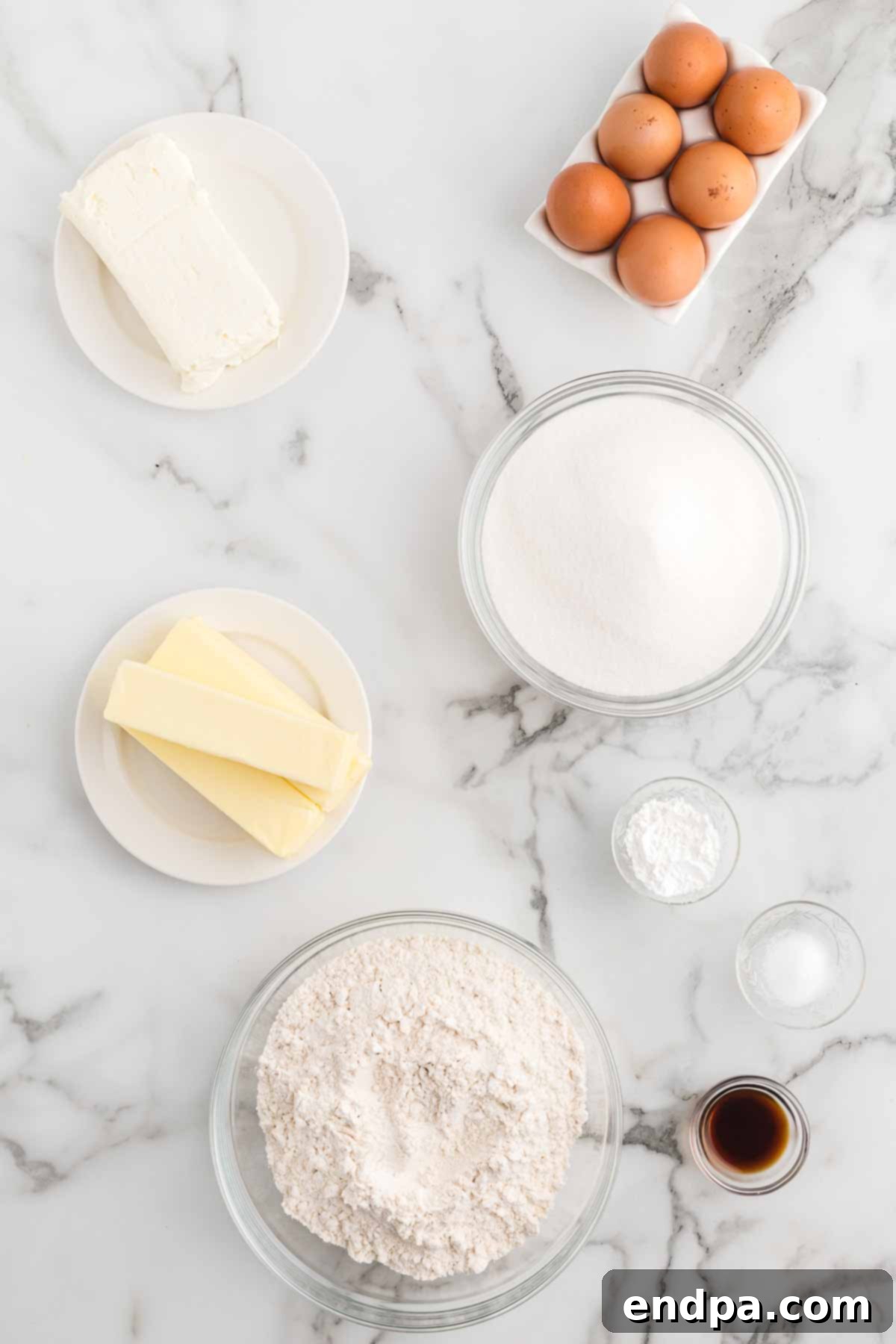
- Unsalted Butter: Ensure it’s softened to room temperature. Using unsalted butter gives you complete control over the salt content in your recipe. Room temperature butter creams beautifully with sugar, incorporating air that contributes to the cake’s lift and tender crumb.
- Full Fat Cream Cheese: Also softened to room temperature. This is the star ingredient! Opt for full-fat cream cheese for the richest flavor and the most luxurious, moist texture. It’s crucial for achieving that signature velvety mouthfeel.
- Granulated Sugar: Provides sweetness and helps create a tender crumb structure by interfering with gluten development. It also assists in the creaming process with the fats.
- Large Eggs: At room temperature. Eggs act as a binder, provide structure, add moisture, and contribute to the cake’s richness. Room temperature eggs emulsify better with the creamed butter and sugar, leading to a smoother, more uniform batter.
- Vanilla Extract: Pure vanilla extract is highly recommended for the best, most authentic flavor. It enhances all the other sweet notes in the cake, adding a layer of aromatic depth.
- All-Purpose Flour: The foundation of our cake’s structure. For accurate measuring, always spoon the flour into the measuring cup and then level it off with a straight edge, rather than scooping directly from the bag. This prevents over-packing the flour, which can lead to a dense, dry cake.
- Baking Powder: A leavening agent that helps the cake rise, contributing to its light and fluffy texture, especially given the density of pound cakes.
- Salt: A small amount of salt is essential to balance the sweetness and enhance all the other flavors in the cake, preventing it from tasting flat.
For the complete, precise measurements of each ingredient, please refer to the detailed recipe card conveniently located at the bottom of this page. Gather your ingredients, and let’s embark on this delightful baking journey!
How to Make Cream Cheese Pound Cake
Creating this delectable Cream Cheese Pound Cake is a straightforward process that yields impressive results. Follow these step-by-step instructions carefully to ensure a perfectly baked, moist, and flavorful cake every time.
- Step 1: Prepare Your Oven and Pan. Begin by preheating your oven to 325 degrees F (160 degrees C). Proper preheating is crucial for even baking. Next, meticulously grease and flour a 10-12 cup bundt pan. This essential step prevents the cake from sticking and ensures a clean release, preserving its beautiful shape.
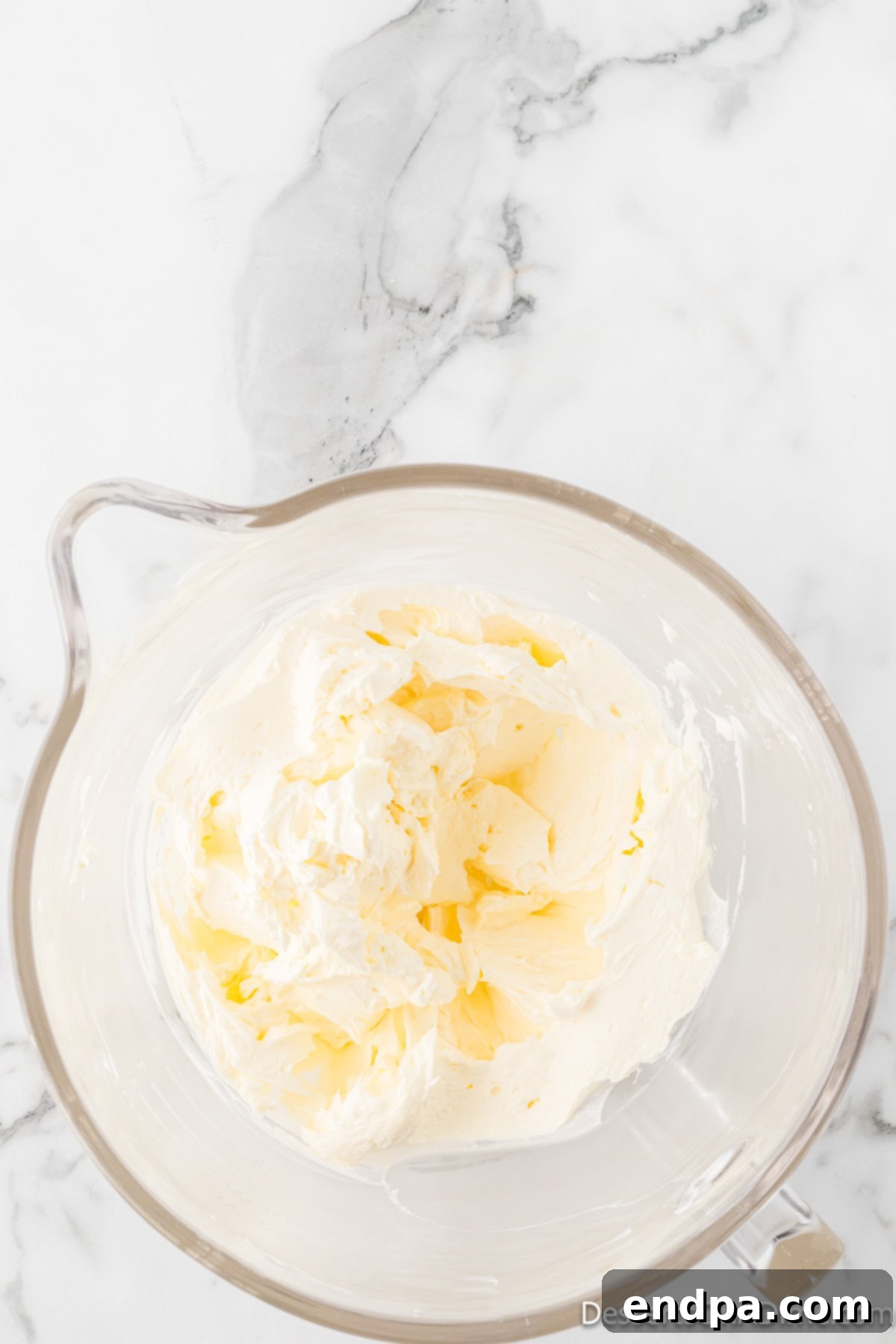
Step 2: Cream the Fats. In a large mixing bowl, using either a stand mixer fitted with the paddle attachment or a handheld electric mixer, combine the softened unsalted butter and full-fat cream cheese. Beat them together on medium-high speed until the mixture is light, fluffy, and thoroughly combined. This process typically takes about 2-3 minutes, and it’s vital for incorporating air into the batter, which contributes to the cake’s tender texture.

Step 3: Continue Creaming. As mentioned, continue beating on high speed for 2-3 minutes to achieve that perfectly light and fluffy consistency. The mixture should appear visibly lighter in color and significantly increased in volume. This aeration is key to a cake that isn’t overly dense.

Step 4: Scrape the Bowl. Periodically stop the mixer and use a rubber spatula to scrape down the sides and bottom of the mixing bowl. This ensures all ingredients are thoroughly incorporated and prevents pockets of unmixed butter or cream cheese.
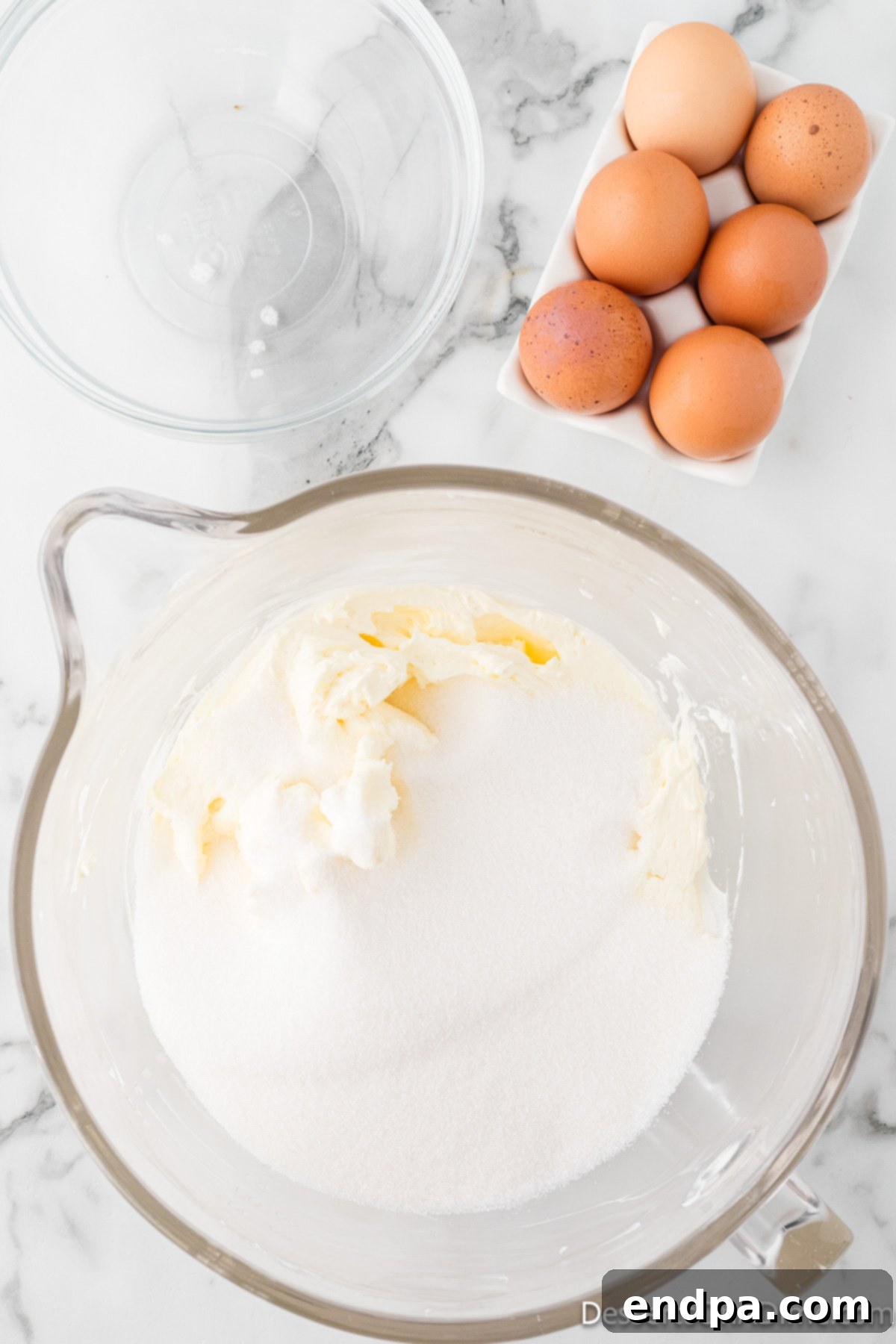
Step 5: Incorporate the Sugar. With the mixer on medium speed, gradually add the granulated sugar to the creamed butter and cream cheese mixture. Continue beating for an additional 3-4 minutes until the mixture is light, fluffy, and the sugar is fully combined and mostly dissolved. The mixture should feel gritty when rubbed between your fingers, but less so than when you started.
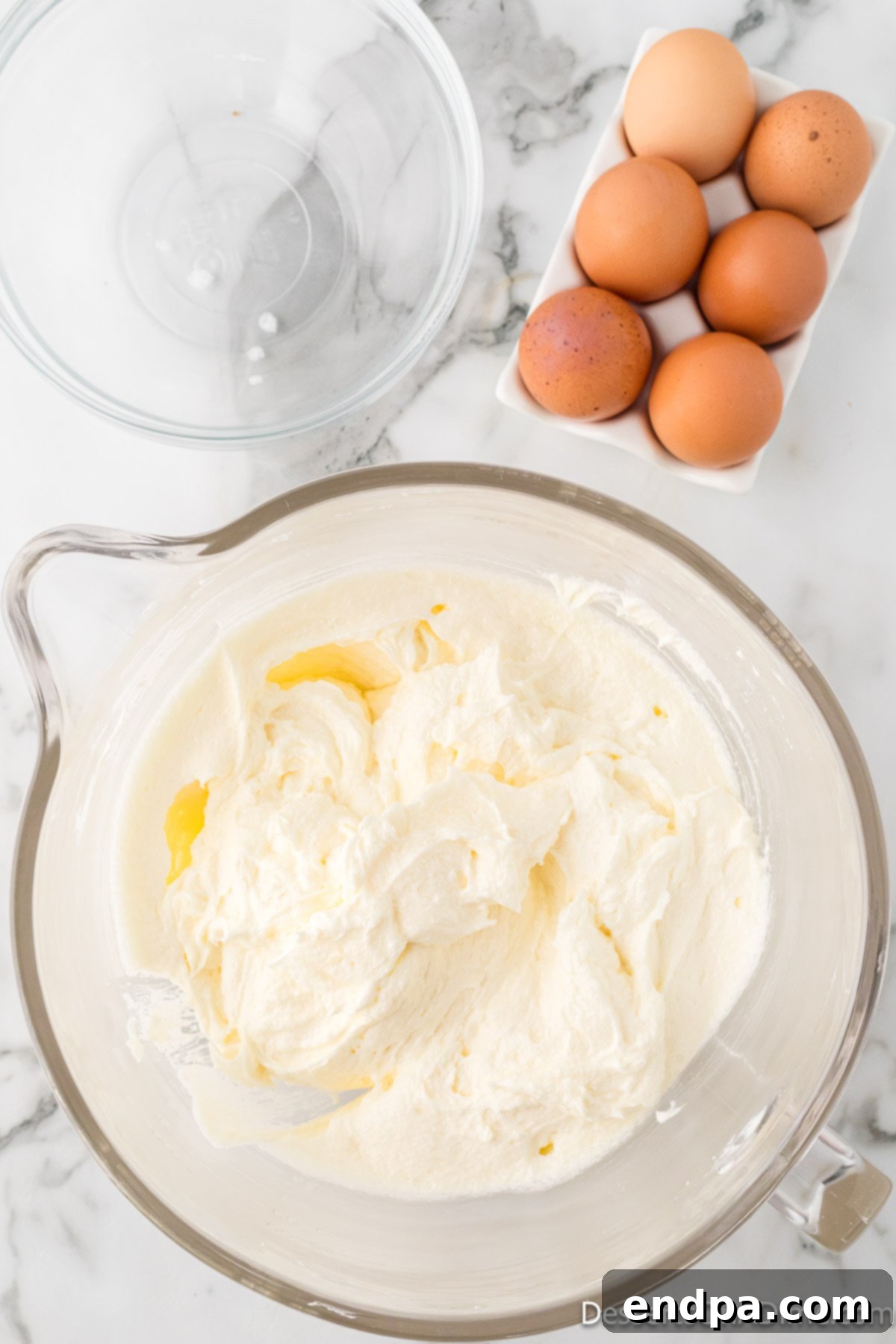
Step 6: Add Eggs One at a Time. Reduce the mixer speed to low. Add the large eggs, one at a time, beating well after each addition. Allow each egg to be fully incorporated before adding the next. This method helps to create a stable emulsion, preventing the batter from curdling and ensuring a smooth, cohesive mixture.
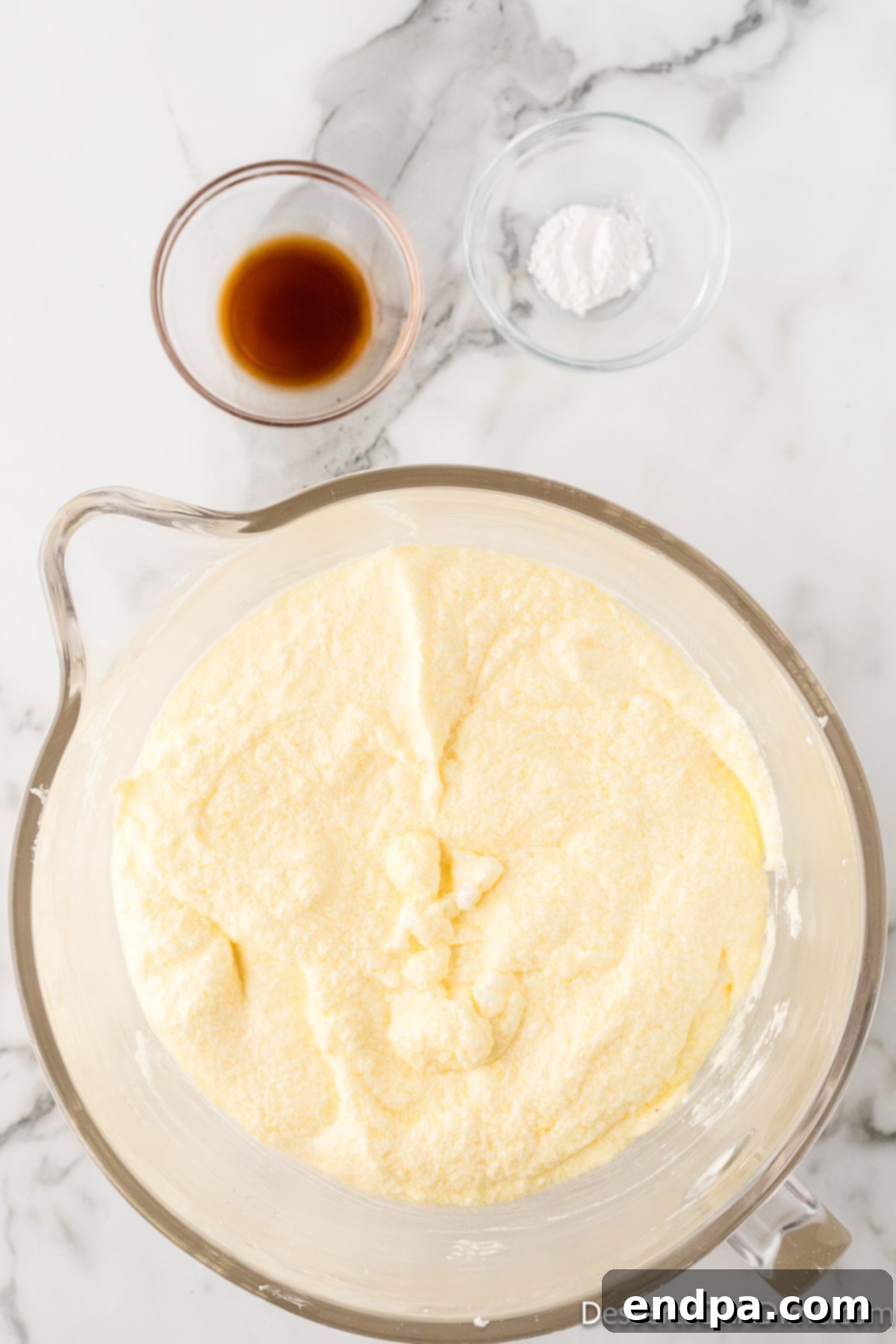
Step 7: Achieve Smoothness. Continue mixing until the entire batter appears smooth and uniform. This indicates a well-emulsified mixture, which is crucial for the final texture of your pound cake. Don’t be tempted to overmix here, just enough to combine.
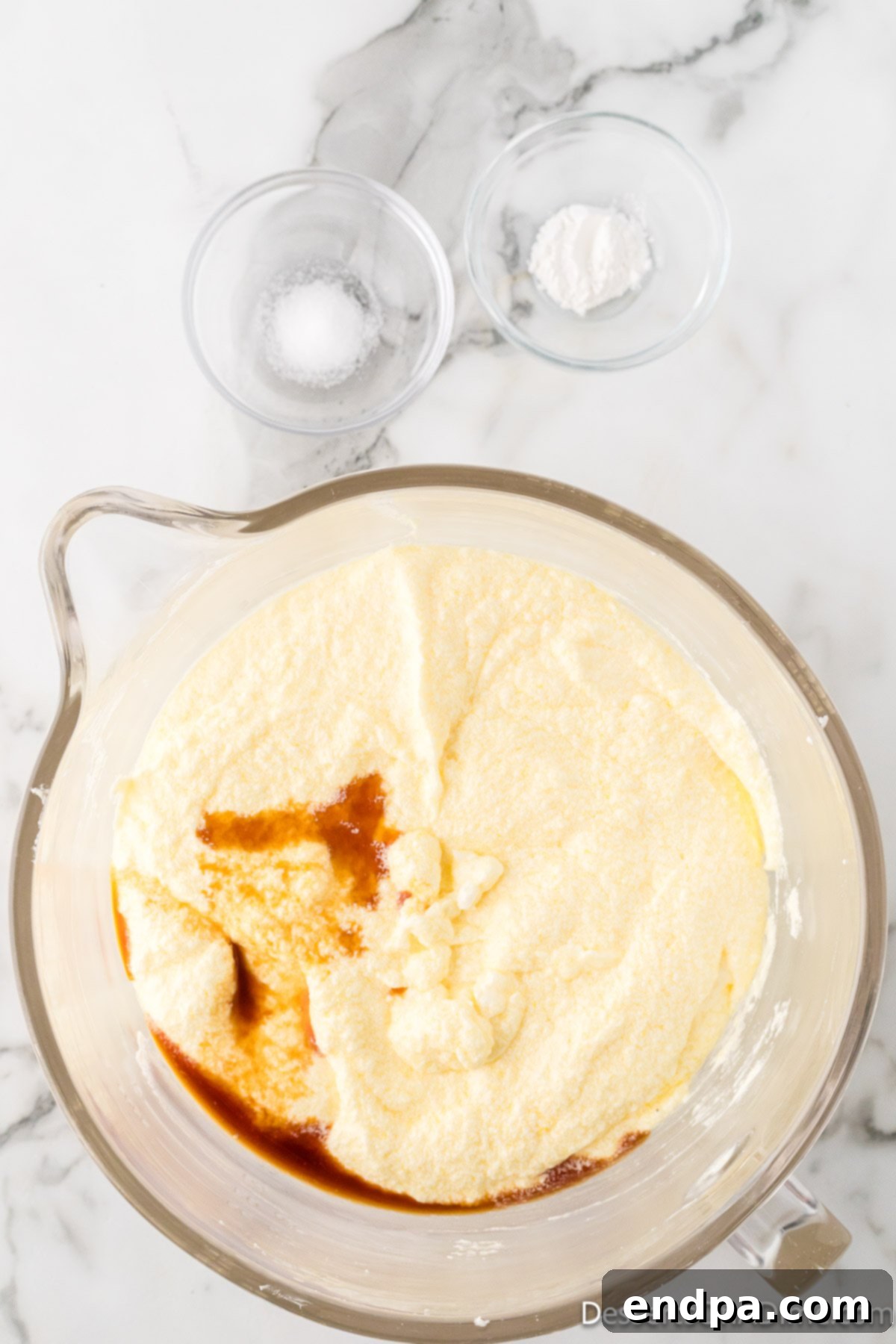
Step 8: Introduce Flavor and Leavening. Now, add the vanilla extract, baking powder, and salt to the batter. Mix on low speed until these ingredients are just incorporated. The vanilla will deepen the overall flavor, while the baking powder ensures a tender lift.

Step 9: Gently Fold in Flour. With the mixer still on low speed, gradually add the all-purpose flour to the wet ingredients. Add about a third of the flour at a time, mixing only until just combined before adding the next portion. This technique helps prevent gluten overdevelopment.
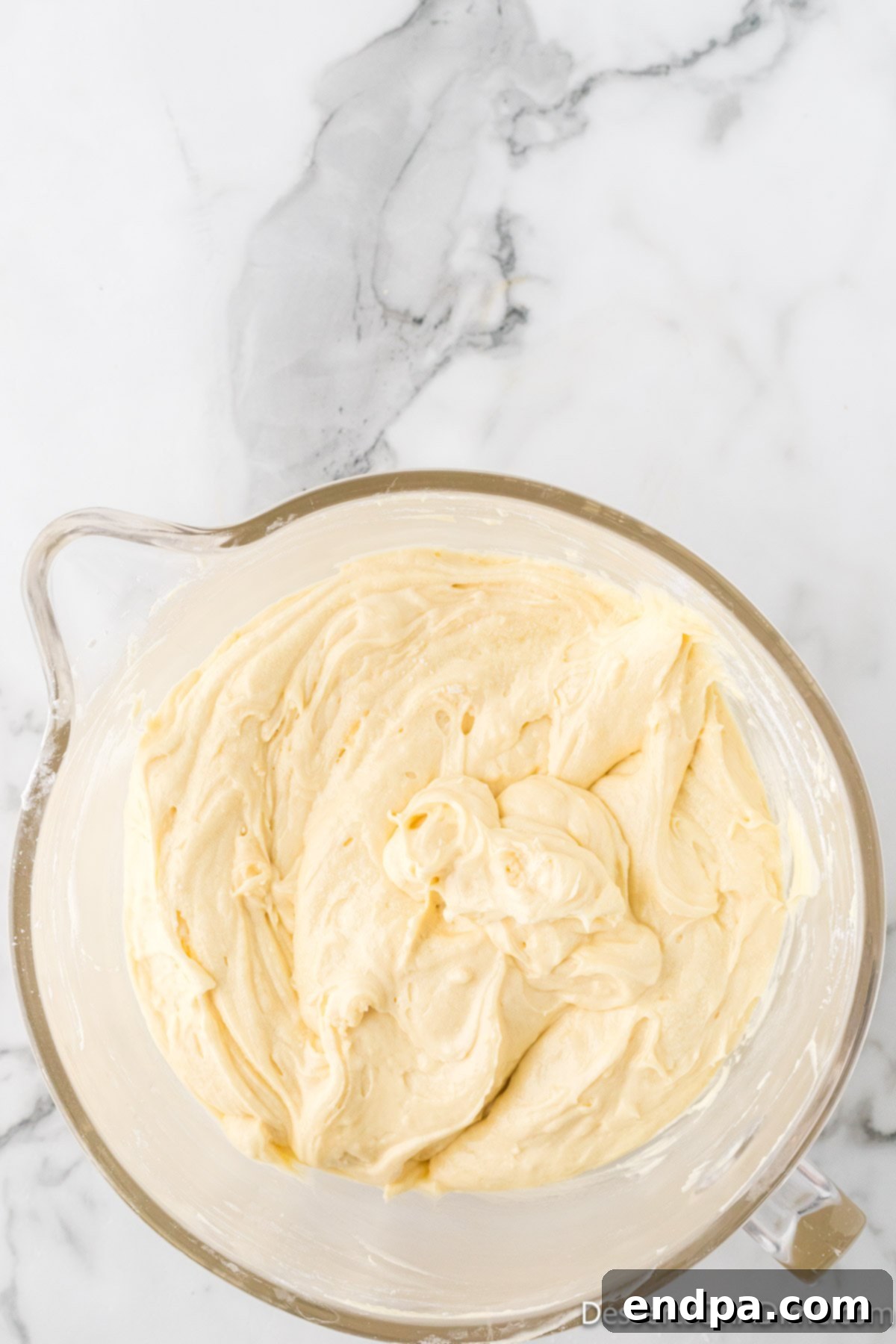
Step 10: Avoid Overmixing. Once all the flour has been added, mix on medium speed for just a short period, only until the ingredients are combined and no streaks of dry flour remain. It is absolutely crucial not to overmix the batter at this stage, as overmixing can develop too much gluten, resulting in a tough and dense pound cake. Stop as soon as it’s homogenous.
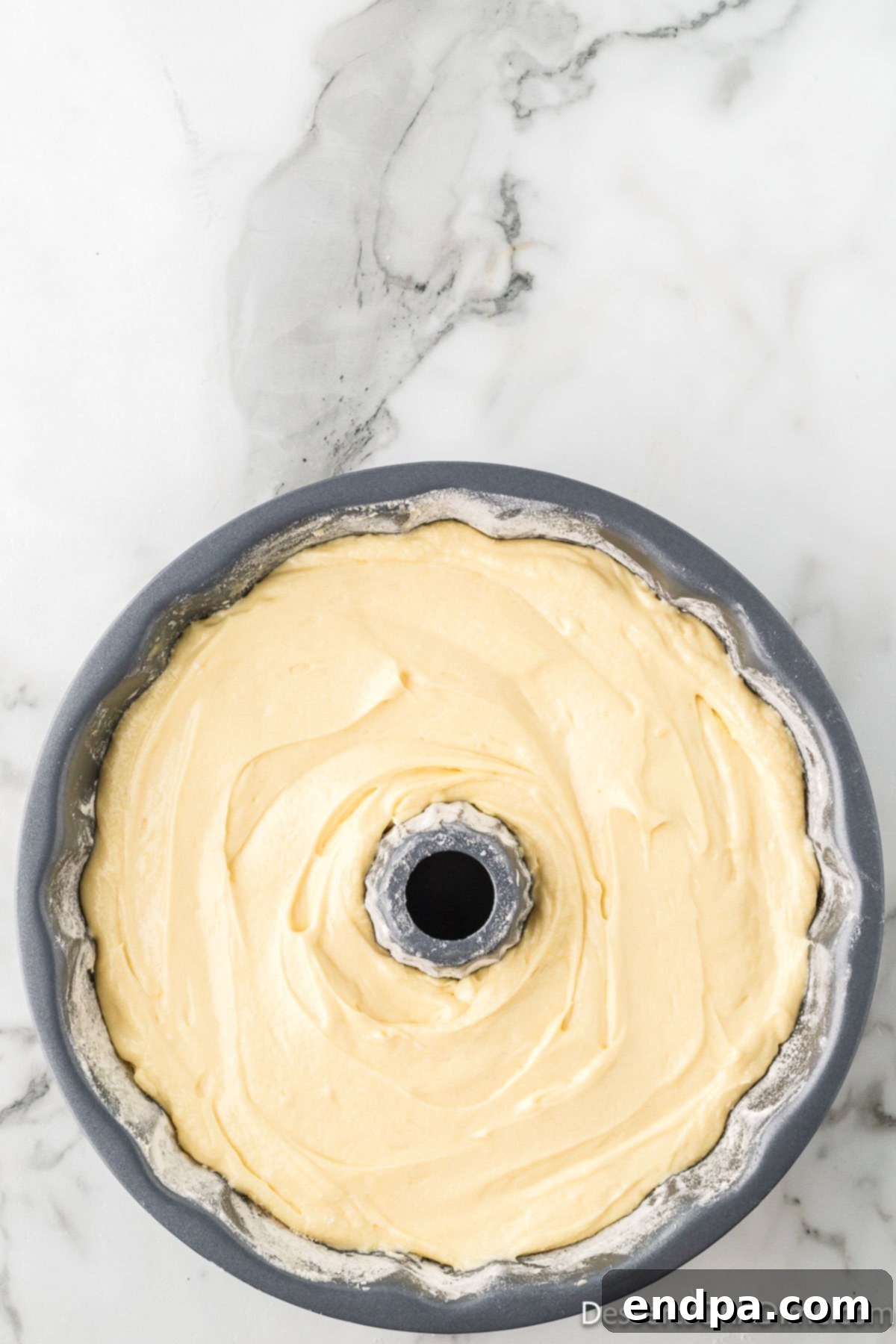
Step 11: Bake to Golden Perfection. Carefully pour the prepared batter into your greased and floured bundt pan, spreading it evenly. Transfer the pan to the preheated oven and bake for 75-90 minutes. Baking time can vary depending on your oven, so rely on a visual cue and the toothpick test: the cake should be beautifully golden brown, and a toothpick inserted into the cake at least 1 inch from the edge of the pan should come out clean. This indicates it’s fully cooked through.
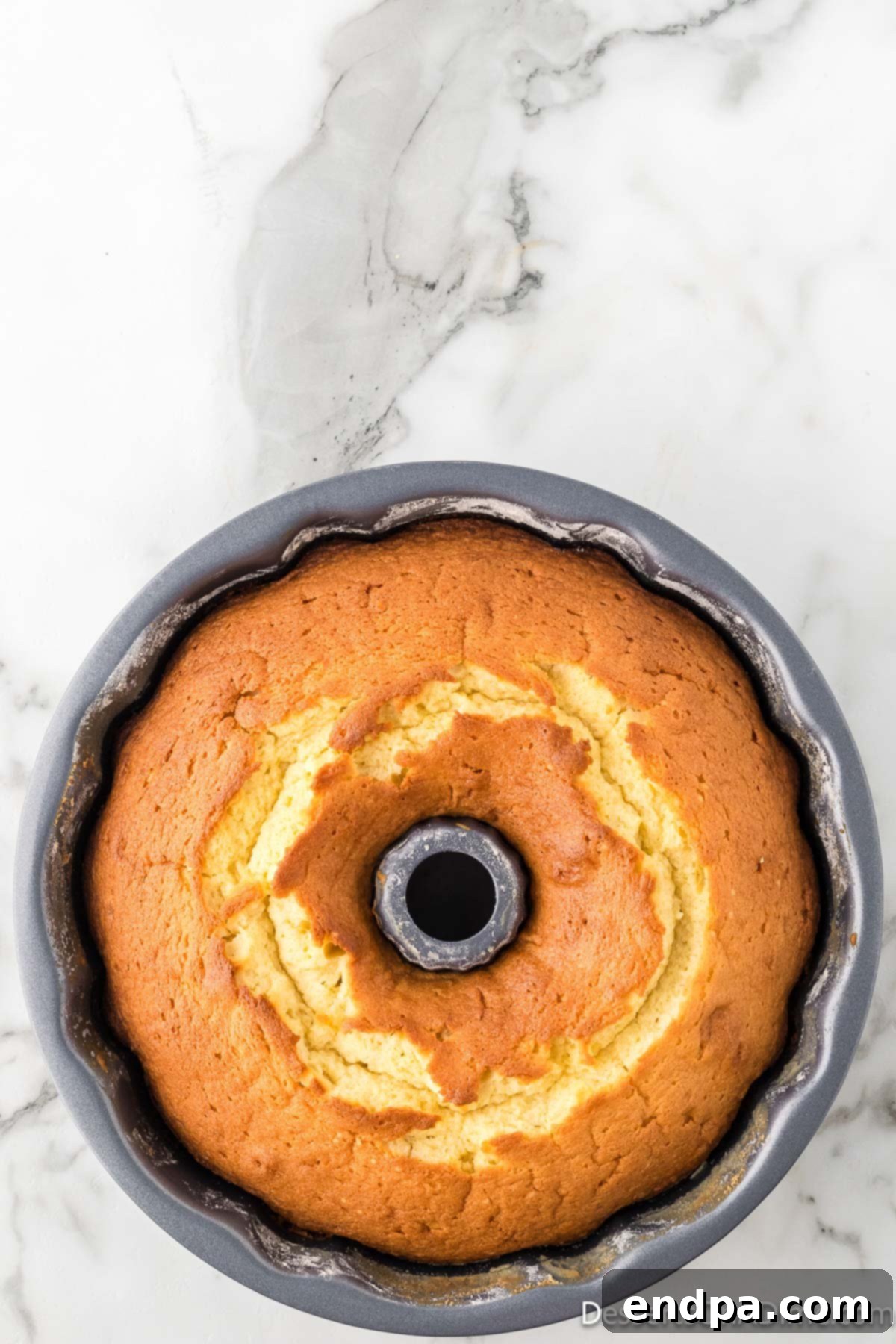
Step 12: Initial Cooling. Once baked, remove the cake from the oven and allow it to cool in the bundt pan for 20-30 minutes. This crucial resting period allows the cake to firm up and prevents it from crumbling when inverted. It also allows the moist heat to redistribute, ensuring a more tender interior.
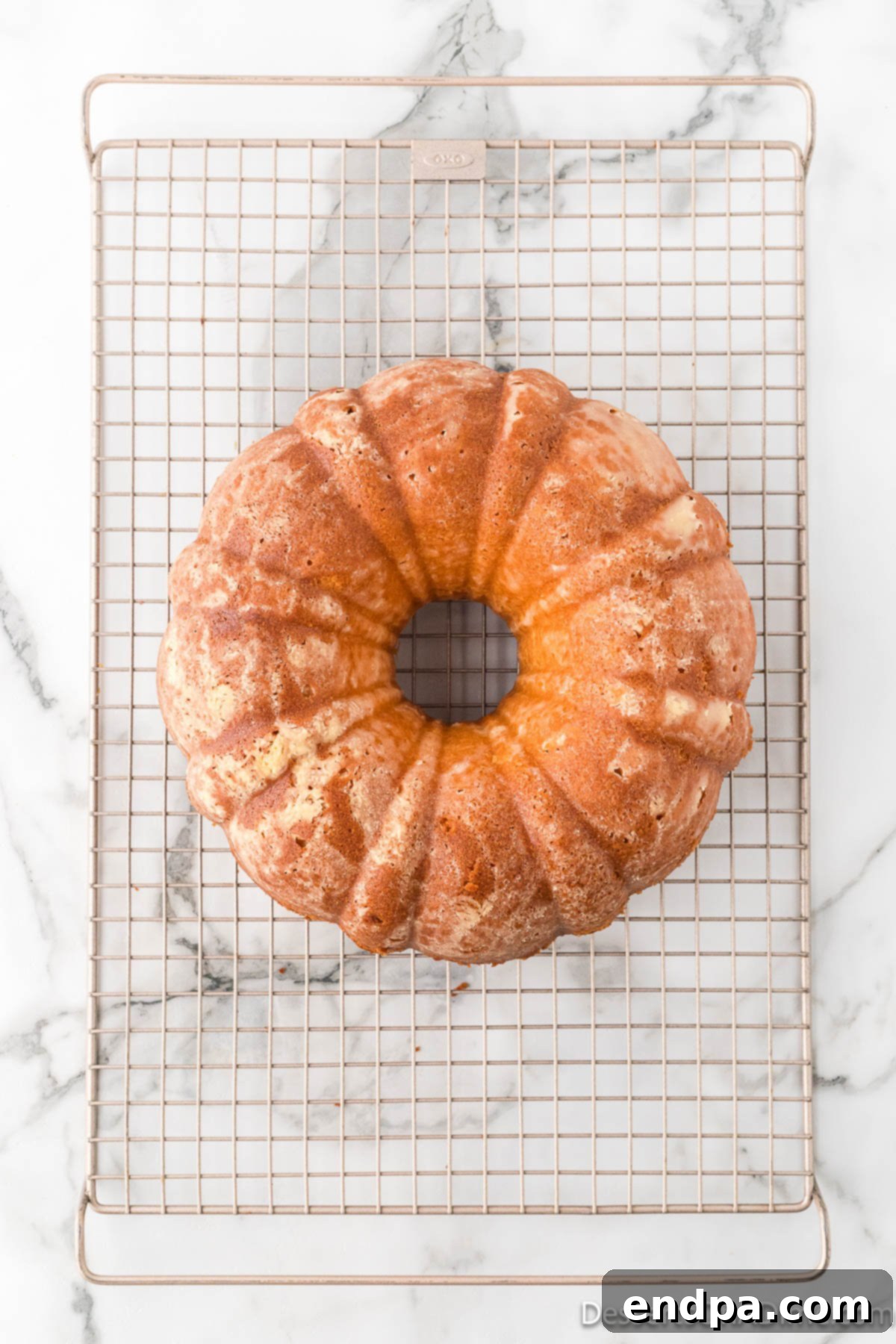
Step 13: Complete Cooling and Serve. After the initial cooling in the pan, carefully invert the cake onto a wire rack to cool completely. This allows air to circulate around the entire cake, preventing sogginess and ensuring a perfectly crisp exterior and tender interior. Once the cake has fully cooled, slice it with a sharp knife, serve, and savor every rich, moist bite!
Elevate Your Cake with Delicious Toppings
While this Cream Cheese Pound Cake is absolutely divine on its own, adding a topping can take it to an even more exquisite level. Here are some fantastic ideas to complement its rich flavor and moist texture:
- Whipped Cream: A dollop of light and airy Homemade Whipped Cream is always a classic choice. Its subtle sweetness and creamy texture provide a perfect contrast to the pound cake’s richness.
- Fresh Berries: A vibrant medley of fresh berries – strawberries, blueberries, and raspberries – adds a burst of freshness, natural sweetness, and a beautiful pop of color. They cut through the richness of the cake beautifully.
- Blueberry Sauce: Beyond fresh, consider a warm, homemade blueberry sauce. Simmer fresh or frozen blueberries with a touch of sugar and lemon juice for a delightful tart-sweet accompaniment.
- Raspberry Coulis: A simple raspberry coulis, made by pureeing and straining raspberries, adds an elegant touch and intense fruit flavor. This is particularly delicious when paired with blueberries for a mixed berry experience.
- Chocolate Sauce: For chocolate lovers, a drizzle of rich Hot Fudge Sauce or a simple chocolate ganache creates a decadent dessert. The warmth of the fudge melting into the cake is pure bliss.
- Cream Cheese Glaze: To further enhance the cream cheese flavor, a simple Cream Cheese Glaze drizzled over the top adds an extra layer of sweetness and a hint of tang. It’s an easy way to make the cake feel extra special.
- Lemon Zest or Glaze: A sprinkle of fresh lemon zest or a tart lemon glaze can brighten the flavors, offering a wonderful counterpoint to the cake’s richness.
- Toasted Nuts: A scattering of toasted pecans or walnuts can add a delightful crunch and nutty flavor, providing textural complexity.

Storage and Freezing Tips
Proper storage is key to keeping your Cream Cheese Pound Cake fresh and delicious for as long as possible. Here’s how to best store your masterpiece:
- Room Temperature Storage: Any leftover cake can be stored in an airtight container at room temperature for up to 2 days. Ensure it’s covered to prevent it from drying out. While it contains cream cheese, the high sugar content acts as a preservative.
- Refrigerated Storage: For extended freshness, especially in warmer climates or if your home is particularly warm, the cake can be refrigerated in an airtight container for up to 5 days. Chilling the cake can sometimes alter its texture slightly, making it a bit firmer, but it will soften once brought back to room temperature.
- Freezing for Long-Term Enjoyment: This recipe freezes exceptionally well, making it perfect for preparing ahead or saving portions for later. For detailed instructions, refer to our guide on Can You Freeze Pound Cake.
- How to Freeze: Allow the cake to cool completely before freezing. Once cool, wrap the entire cake or individual slices tightly in plastic wrap, followed by a layer of aluminum foil. This double-layer protection prevents freezer burn.
- Storage Duration: Place the wrapped cake or slices inside an airtight freezer-safe container or a heavy-duty freezer bag. It can be frozen for up to 4 months for best quality, although it can often last longer. Freezing in slices is convenient for thawing only what you need.
- Thawing: When you’re ready to enjoy a slice, simply transfer the frozen cake (or slices) to the refrigerator to thaw overnight, or leave it at room temperature for a few hours. Once thawed, it will be as delicious as freshly baked.
Expert Baking Tips for Pound Cake Perfection
Achieving a consistently perfect Cream Cheese Pound Cake is easier than you think, especially when you keep a few key baking principles in mind. These expert tips will guide you to a flawless result every single time:
- Don’t Overbake: This is arguably the most critical tip for any cake, especially pound cake. Overbaking can quickly lead to a dry, crumbly, and unappetizing pound cake. Always rely on the visual cues (golden brown crust) and the toothpick test – insert it into the cake, and if it comes out clean or with a few moist crumbs attached, your cake is done. Remove it promptly from the oven.
- Use Good Quality Ingredients: The flavor and texture of your pound cake are directly influenced by the quality of your ingredients. Invest in real unsalted butter (not margarine), high-quality full-fat cream cheese, and pure vanilla extract. These superior ingredients will shine through in the final taste.
- Room Temperature Ingredients are Non-Negotiable: This cannot be stressed enough. Ensure your butter, cream cheese, and eggs are all at room temperature before you begin mixing. Room temperature fats cream together smoothly and efficiently, trapping more air, which results in a lighter, fluffier cake. Room temperature eggs emulsify better, creating a homogeneous batter that is less likely to curdle.
- Don’t Overmix the Batter (Especially After Adding Flour): Overmixing, particularly once the flour has been added, develops the gluten too much. This leads to a tough, dense, and chewy cake, rather than the desired tender pound cake texture. Mix only until the ingredients are just combined and no streaks of dry flour remain.
- Opt for Full-Fat Ingredients: For this specific recipe, full-fat cream cheese and butter are essential. Reduced-fat or fat-free versions contain more water and less fat, which will significantly alter the cake’s texture and richness, often resulting in a less flavorful and drier cake. Stick to full-fat for that luxurious taste.
- Correct Measuring of Flour: Baking is a science, and precise measurements are vital. When measuring flour, do not scoop it directly from the bag with your measuring cup, as this compacts the flour and results in too much being used. Instead, gently spoon the flour into your measuring cup until it’s overflowing, then level it off with the back of a knife or a straight edge. This method ensures you use the correct amount and prevents a dense cake.
- Proper Pan Preparation: Thoroughly greasing and flouring your bundt pan is crucial to prevent sticking. You can also use a baking spray with flour. Don’t skip the step of letting the cake cool in the pan for the specified time before inverting. This allows it to set and makes for easier removal.
By diligently following these simple yet crucial tips, your Cream Cheese Pound Cake will turn out perfectly baked, wonderfully moist, and utterly delicious every single time. Baking a pound cake doesn’t have to be complicated; precise execution of these instructions will ensure the best results and a dessert that impresses everyone.
Frequently Asked Questions
For this Cream Cheese Pound Cake recipe, we recommend a traditional 10-12 cup bundt cake pan, as specified in the instructions. Its decorative fluted design creates beautiful slices. However, if you don’t have a bundt pan, you can certainly use a standard tube pan, which will yield a similar dense and tall cake, or even two standard loaf pans for smaller, more manageable cakes. Just be mindful that changing the type of pan will likely vary the cooking time. Tube pans and loaf pans typically require less baking time than a large bundt pan, so keep a close eye on your cake and use the toothpick test frequently to check for doneness.
Yes, pound cake freezes exceptionally well, making it a fantastic make-ahead dessert or for enjoying later. To freeze, ensure the cake has cooled completely to room temperature. Then, wrap it tightly first in plastic wrap, followed by a layer of aluminum foil. This double wrapping helps prevent freezer burn. Place the well-wrapped cake inside an airtight freezer-safe container or a heavy-duty freezer bag. It can be frozen for up to 4 months while maintaining optimal quality, though it can remain safe to eat for longer. You have the option to freeze the entire cake or individual slices. Freezing in slices is often more convenient, as you can thaw only the amount you need. When you’re ready to serve, simply transfer the frozen cake or slices to the refrigerator to thaw overnight, or let them sit at room temperature for a few hours. Enjoy its fresh-baked taste once thawed!
Preventing your pound cake from sticking to the pan is crucial for a beautifully presented dessert. The key lies in thorough pan preparation and correct cooling. First, ensure you meticulously grease and flour your bundt or tube pan before adding the batter. Use a good quality baking spray, or brush generously with softened butter or shortening, then dust thoroughly with all-purpose flour, tapping out any excess. This creates a non-stick barrier. Secondly, allow the proper cooling time: let the cake cool in the pan for 20-30 minutes after baking. This allows the cake to firm up and pull away from the sides. However, do not let it stay in the pan for too long after this initial cooling period. If left too long, the cake can become damp from residual steam, causing it to stick. It is crucial to invert the cake onto a wire rack within the specified cooling time in the pan; waiting too long will make it incredibly difficult to remove and likely result in a messy, broken cake.
A dense or dry pound cake often stems from a few common mistakes. Overmixing the batter, especially after the flour has been added, is a frequent culprit. This develops too much gluten, leading to a tough, dense texture. Mix only until the ingredients are just combined. Another reason is overbaking, which dries out the cake. Always monitor baking time closely and rely on the toothpick test. Incorrect flour measurement (too much flour, often from scooping directly with the measuring cup) can also lead to a dry cake. Ensure you spoon and level your flour. Lastly, not using room temperature ingredients can affect the emulsion, resulting in a less airy and potentially denser crumb.
While it might be tempting to opt for low-fat ingredients, for the best results in this Cream Cheese Pound Cake, it’s strongly recommended to use full-fat cream cheese and real unsalted butter. Low-fat versions contain more water and less fat, which will significantly impact the cake’s signature rich flavor, moistness, and tender texture. The higher water content can also alter the chemical balance in the recipe, potentially leading to a denser or drier cake. Margarine, similarly, has a different fat and water composition than butter and will not yield the same superior flavor or texture. Stick to the full-fat, high-quality ingredients specified for an authentic and delicious pound cake experience.
More Easy Pound Cake Recipes
If you’ve fallen in love with the simplicity and decadence of this Cream Cheese Pound Cake, you’ll be thrilled to explore other delightful variations. Pound cakes are incredibly versatile, offering endless possibilities for flavor combinations. Here are a few more easy pound cake recipes to inspire your next baking adventure:
- Peach Cobbler Pound Cake: A delicious fusion of two Southern classics, offering the warmth of peach cobbler in a tender pound cake form.
- Red Velvet Pound Cake Recipe: Indulge in the iconic red velvet flavor with its subtle chocolate notes and vibrant color, baked into a rich pound cake.
- Easy Lemon Pound Cake Recipe: A bright and zesty option that’s perfect for spring and summer, offering a refreshing citrus kick.
We encourage you to make this Cream Cheese Pound Cake today and discover for yourself just how effortlessly you can create one of the best pound cake recipes. It is truly the perfect dessert for any occasion, whether it’s your next potluck, a festive holiday gathering, or a special birthday celebration. Once you’ve tried it, please share your experience and let us know how wonderfully it turned out in the comments below!

Pin
Cream Cheese Pound Cake Recipe
15
1
15
30
2
12
American
Dessert
577
Carrie Barnard
Ingredients
- 1.5 cups Unsalted Butter softened at room temperature
- 1 pkg Full Fat Cream Cheese softened at room temperature
- 2.5 cups Granulated Sugar
- 6 Large Eggs room temperature
- 2 tsp Vanilla Extract
- 3 cups All Purpose Flour
- 1 tsp Baking Powder
- 1/2 tsp Salt
Instructions
- Preheat the oven to 325 degrees F (160°C).
- Grease and flour a 10-12 cup bundt pan thoroughly to prevent sticking.
- Using a stand mixer with the paddle attachment or a hand-held mixer, beat the softened butter and cream cheese together on medium-high speed until the mixture is light and fluffy, about 2-3 minutes. Scrape down the sides of the bowl as needed.
- Gradually add the granulated sugar to the creamed mixture and continue beating for approximately 3-4 more minutes until it’s well combined and lighter in color. Reduce speed to low and add the large eggs one at a time, ensuring each is fully incorporated before adding the next.
- Mix in the vanilla extract, baking powder, and salt until just combined.
- Gradually add the all-purpose flour to the bowl, mixing on medium-low speed only until just combined and no streaks of dry flour remain. Be careful not to overmix the batter, as this can lead to a dense and tough cake.
- Pour the batter evenly into the prepared bundt pan. Bake for 75-90 minutes, or until the cake is golden brown and a toothpick inserted into the cake (at least 1 inch from the edge) comes out clean.
- Remove the cake from the oven and allow it to cool in the pan for 20-30 minutes. This allows it to firm up and pull away from the sides.
- After the cooling period in the pan, carefully invert the cake onto a wire rack to cool completely before slicing, serving, and enjoying.
Recipe Notes
For accurate measuring, spoon the flour into the measuring cup and level it off with a straight edge, rather than scooping directly, to avoid a dense cake.
Store any leftover cake in an airtight container at room temperature for up to 2 days or in the refrigerator for up to 5 days. It can also be frozen for longer storage (see storage tips).
Nutrition Facts
Calories
577
kcal
,
Carbohydrates
67
g
,
Protein
7
g
,
Fat
32
g
,
Saturated Fat
19
g
,
Polyunsaturated Fat
2
g
,
Monounsaturated Fat
8
g
,
Trans Fat
1
g
,
Cholesterol
162
mg
,
Sodium
227
mg
,
Potassium
97
mg
,
Fiber
1
g
,
Sugar
43
g
,
Vitamin A
1082
IU
,
Calcium
62
mg
,
Iron
2
mg
Pin This Now to Remember It Later
Pin Recipe
